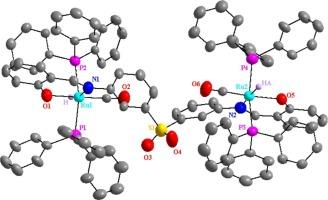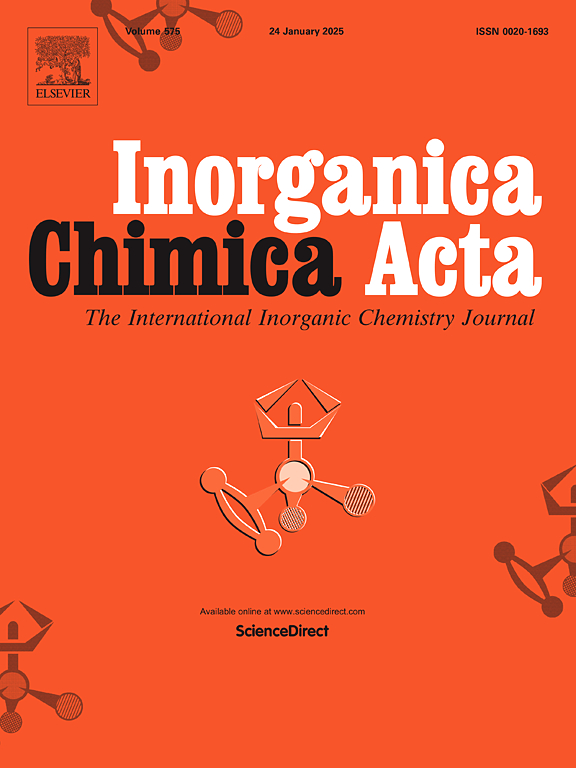Photocatalytic properties and antioxidant activities of a binuclear ruthenium(II) complex with bis-bidentate N2O2 Schiff base ligand
IF 3.2
3区 化学
Q2 CHEMISTRY, INORGANIC & NUCLEAR
引用次数: 0
Abstract
A series of bidentate N2O2 Schiff base ligands and a new binuclear ruthenium(II) complex with a Schiff base ligand were successfully synthesized. The molecular structures of bis-bidentate N2O2 Schiff base ligands H2L1 (4,4’-Sulfonylbis(N-(2-hydroxybenzylidene)aniline)), H2L2 (4,4’-Sulfonylbis(N-(2-hydroxy-4-chlorobenzylidene)aniline)), H2L3 (4,4’-Sulfonylbis(N-(2-hydroxy-4,6-dibromobenzylidene)aniline)) and L1-Ru2 (L1[Ru(CO)H(PPh3)2]2) were confirmed by single-crystal X-ray crystallography and characterized by IR, NMR, and UV–vis spectroscopy along with microanalyses. The Ru(II) complex has N2O2 metal binding sites that are interconnected by biphenyl-sulfone bridge. The crystal structures of H2L1–3 adopt the anti-closed conformer. The ruthenium atoms in the binuclear neutral complex species have identical coordination octahedron environments, RuNOP2HCl. Furthermore, antioxidant activity and photocatalytic property of the Ru(II) complex was also investigated, exhibiting high antioxidant activity and stable photocatalytic hydrogen production performance.

双双齿N2O2希夫碱配体双核钌配合物的光催化性能和抗氧化活性
成功地合成了一系列双齿N2O2希夫碱配体和一个新的双核钌(II)配合物。用单晶x射线晶体学证实了双双齿N2O2希夫碱配体H2L1(4,4′-磺酰基双(N-(2-羟基苄基)苯胺))、H2L2(4,4′-磺酰基双(N-(2-羟基-4-氯苄基)苯胺)、H2L3(4,4′-磺酰基双(N-(2-羟基-4,6-二溴苄基)苯胺))和L1- ru2 (L1[Ru(CO)H(PPh3)2]2)的分子结构,并用红外、核磁共振、紫外-可见光谱及微量分析对其进行了表征。Ru(II)配合物具有通过联苯砜桥连接的N2O2金属结合位点。H2L1-3的晶体结构采用反闭合的构象。双核中性络合物中的钌原子具有相同的配位八面体环境,RuNOP2HCl。此外,还研究了Ru(II)配合物的抗氧化和光催化性能,发现其具有较高的抗氧化活性和稳定的光催化制氢性能。
本文章由计算机程序翻译,如有差异,请以英文原文为准。
求助全文
约1分钟内获得全文
求助全文
来源期刊

Inorganica Chimica Acta
化学-无机化学与核化学
CiteScore
6.00
自引率
3.60%
发文量
440
审稿时长
35 days
期刊介绍:
Inorganica Chimica Acta is an established international forum for all aspects of advanced Inorganic Chemistry. Original papers of high scientific level and interest are published in the form of Articles and Reviews.
Topics covered include:
• chemistry of the main group elements and the d- and f-block metals, including the synthesis, characterization and reactivity of coordination, organometallic, biomimetic, supramolecular coordination compounds, including associated computational studies;
• synthesis, physico-chemical properties, applications of molecule-based nano-scaled clusters and nanomaterials designed using the principles of coordination chemistry, as well as coordination polymers (CPs), metal-organic frameworks (MOFs), metal-organic polyhedra (MPOs);
• reaction mechanisms and physico-chemical investigations computational studies of metalloenzymes and their models;
• applications of inorganic compounds, metallodrugs and molecule-based materials.
Papers composed primarily of structural reports will typically not be considered for publication.
 求助内容:
求助内容: 应助结果提醒方式:
应助结果提醒方式:


